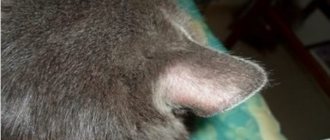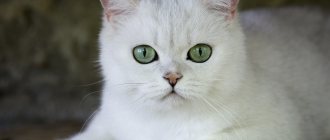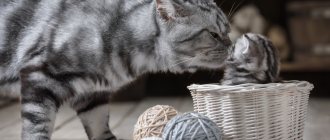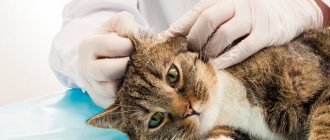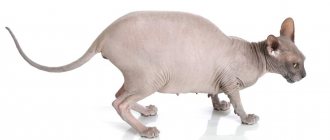If white worms appear in a cat's feces, this indicates the appearance of tapeworms in the animal's body. This is a fairly common occurrence, especially if the pet is free to roam outdoors. The danger of tapeworms lies in the fact that they cause mechanical damage to organ tissues, as a result of which the vessels are destroyed and the tissues begin to die. Cats that do not go outside can also become infected with worms by eating raw fish or meat or drinking dirty water. Often, owners accidentally bring helminth larvae from the street.
Types of worms
All types of helminths are large and small white worms (they can often be seen in feces). Their length can vary from a few millimeters to two meters. If white worms are moving in the cat's feces, this means that the infection is quite strong.
There are mainly 3 types of worms found in cats.:
- Tapeworms live in human and cat intestines. Infection with parasites occurs due to the consumption of raw pieces of meat and fish. White tapeworms lead to alveococcosis, dipylidiasis, diphyllobothriasis, and are very dangerous for humans.
- Roundworms are distinguished by incredible vitality and agility. The causes of infection are worm eggs on clothing or after contact with the feces of infected animals. White roundworms cause toxascariasis and hookworm disease. If treatment is not carried out in a timely manner, the intestines of a kitten or adult cat can be torn by a large number of worms.
- Flat flukes are rare in cats, but they are dangerous. Infection occurs when animals eat river fish or shellfish. Flat flukes cause opisthorchiasis and paragonimiasis. After infection, the kitten becomes very restless and has constant and severe stomach pain. The pet will die if therapy is not carried out in a timely manner.
Each type of worm poses a danger not only to animals, but also to humans.
Treatment and prevention of worms
Treatment and prevention of helminthic diseases are carried out with the same drugs, or more precisely, active ingredients. The only difference is that when treating long-term helminthic infestations, additional precautions or therapy may be required. The composition of all drugs for worms is similar and usually includes two active ingredients.
Substances that eliminate roundworms:
Substances that eliminate tapeworms:
The dosage form in the form of drops may have a complex property - eliminate external and internal parasites. In this case, the drug will contain a third active ingredient:
Important! Strictly follow the dosage of the drug and carefully read the instructions before use. Poisoning with prophylactic drugs provokes additional intoxication, which has a very detrimental effect on the functioning of the heart, kidneys and liver.
If drugs are used for prophylaxis, the application algorithm is as follows:
- Tablets and suspension - given in the morning on an empty stomach, on the root of the tongue. If you cannot give your cat the medicine, it can be mixed with a small amount of food. The tablets are pre-crushed into powder.
- Drops are applied to the withers or back of the head at any time convenient for you. Until the drops are completely absorbed (usually 2-4 hours), you need to monitor your pet so that he does not lick the drug or use an Elizabethan collar.
Critical helminthic infestations require additional precautions. Be sure to consult your veterinarian before starting treatment. Most likely, the animal will be prescribed shock and maintenance therapy to prepare the body for the load.
If there is a threat of intestinal blockage or perforation, an incomplete dose of the drug is used, after which the cat is given an adsorbent and a laxative. Such measures lead to only partial death of the parasites, so the drug is repeated after 5–14 days.
Symptoms of helminthiasis
Signs of parasites appearing in an animal’s body can be different. Symptoms directly depend on the type of helminths that have entered the cat’s body and the degree of worm damage.
At the initial stage, the disease does not detect itself, but progresses very quickly, as a result of which the cat becomes weaker day by day.
The main signs of worm infection:
- The animal becomes lethargic and gets tired quickly.
- Small white worms appear in the cat's stool.
- The pet's belly becomes dense and severe bloating can be observed.
- The cat loses its appetite and may refuse food.
- The fur loses its shine and begins to fall out.
- Vomit.
- Problems with passing stool. Constipation alternates with intestinal upset.
- A cat can “ride” on its butt.
- The pet becomes nervous and restless.
Stool color and consistency in a healthy animal
The appearance of feces allows you to assess the health of a cat, cat or kitten. Normally, feces should be:
- dark brown;
- well formed (into a sausage);
- dense;
- wet.
Feces have a specific, mild odor. If the stool smells strongly, this also indicates problems with digestion.
In animals that eat primarily meat, the color of their stool is deep brown. When your pet's diet is dominated by dairy products, the feces will turn light brown or yellow.
If a cat, cat or kitten has white stool, this indicates the development of the disease. The owner needs to observe the animal for several days. If the stool continues to be an unnatural color, you need to reconsider your pet's diet or consult a veterinarian.
Treatment of helminthic infestation
If your cat often walks outdoors, then worm prevention should become a regular event. Preventing the appearance of white worms in a cat’s feces involves taking anthelmintic drugs to the animal twice a year. If the risk of infection is very high, then deworming is done once every 3 months. 2 weeks before vaccination it is necessary to give the cat an anti-worm medication.
Typically, anthelmintic drugs are given twice, with an interval of 10-14 days. A one-time treatment will be ineffective, since only adult individuals will die, but the eggs will remain. The second dose of the medicine will destroy the worms that have just emerged from the eggs. There are drugs that destroy all stages of parasite development in one go, for example, Profender, Milbemax.
Worms in a kitten's stool indicate a white worm infection and should be treated immediately.
In cats, the color of feces is determined by bile, which flows from the gallbladder into the lumen of the duodenum in a certain amount. This happens when the animal is healthy. Normally, cat feces are dark brown in color, and most pathologies of the gastrointestinal tract associated with the flow of bile into the small intestine can be determined by changes in their shade. White feces in a cat is an alarming sign, which should be a reason for increased attention to the health of your mustachioed pet and an incentive to consult a veterinarian.
What do adult worms look like (dead and alive)
According to generally accepted rules, a cat must be treated for worms quarterly. The logic here is as follows - you cannot protect your cat from becoming infected with parasites, but you can control their numbers. Within 3–4 months, the invasion becomes noticeable, the worms become adults and the animal’s body begins to suffer from them.
Remember! By carrying out prevention regularly, you reduce peak infestation to a minimum and interrupt the reproduction cycles of most types of worms.
What happens if worm prevention has not been carried out for six months or more? Worms multiply and occupy the intestinal lumen, which will lead to irritation and inflammation.
Irritation of the intestinal walls leads to:
- Nausea and vomiting.
- Diarrhea with a lot of mucus.
Note! If the infestation is severe, diarrhea may alternate with constipation as the worms physically block the intestinal lumen.
Along with vomit and feces, worms (dead or alive) may begin to come out of the cat’s body. If the worm dies, its body may be partially digested - it looks like a white thread covered in transparent mucus.
The influence of nutrition on the color of excrement
In veterinary medicine, white feces are called acholic. Literally, this means “lack of bile” (Greek: chole - bile, a - without). But white feces do not always indicate serious health problems. This is always considered a pathology, but sometimes the condition is reversible in the shortest periods of time only with the help of nutritional correction.
White feces in a cat can be due to:
- feeding with bones (liver function is disrupted);
- states of dehydration (in addition to the color, the stool becomes dense and “free-flowing”);
- improper dosing or long-term use of medications that affect the gastrointestinal tract and liver system (antibiotics, sorbents);
- feeding excessively fatty foods (not always and not for everyone, but often);
- digestive disorders due to stress;
- too much dairy products (stool becomes light yellow, sometimes turning white, due to indigestion due to fermentation in the intestines).
How to avoid getting worms from your pet?
How to avoid getting worms from a cat? Basic hygiene rules will help protect yourself and your family members. Be sure to wash your hands after handling an infected animal. To feed your pet, you must use separate dishes; if there are children in the house, clearly explain to them that the cat cannot be treated from your plate.
Worm eggs can be spread through saliva, feces and vomit. Until the animal has completed the full course of treatment, avoid close contact. Make a habit of wearing gloves when cleaning the litter box and washing your hands thoroughly afterwards. If you use sand to fill the tray, it must be refreshed once every 3–7 days.
The most reliable way to protect yourself is regular prevention. It is important to understand that you are much more likely to “catch” parasites if you are in public places and transport. Not only the four-legged dog, but also all family members should receive anthelmintic drugs. Prevention for people, according to general recommendations, is carried out once every six months (in spring and autumn).
When colorless stool is a cause for concern
Sometimes a cat's white feces can be due to more serious health reasons than poor diet. In most cases, these are deviations in the functioning of the biliary tract and the liver as a whole:
- any metabolic disorders and/or inflammatory processes in the liver (hepatosis, hepatitis);
- pancreatic enzymatic insufficiency;
- blockage or deformation of the bile ducts or gallbladder (most often due to cholelithiasis, compression of organs, torsions, adhesions);
- purulent abscess or cysts;
- cirrhosis of the liver (when there is not enough bile initially produced in the liver);
- cholangitis, cholangiohepatitis - inflammation of the bile ducts, gallbladder, or all at once;
- some renal pathologies, in which toxic products accumulate in the blood, which then affect the functioning of the liver;
- any tumor growths in the liver or biliary system that prevent the release of bile into the intestines;
- atony of the gallbladder (lack of contractions).
Owner actions
If white feces are found in the tray, you need to analyze what was present in the cat’s diet over the last 2-3 days. If we are talking about milk, bones, fatty, spicy foods, there may be errors in nutrition. It is enough to exclude these products, transfer the animal to a normal diet (ready-made industrial feed, natural food - meat + cereals + vegetables) and the functioning of the biliary tract will improve.
If changing the diet has no effect, and white feces remain, the cat feels unwell (lethargy, refusal to feed, vomiting, etc.), you need to urgently take the pet to a veterinary clinic. Or call a doctor at home (+7) - at the RosVet EC the team works 24 hours a day.
What else can accompany white feces?
Any deviations in the color of feces and their consistency indicate dysfunction of the gastrointestinal tract and bile-hepatic system:
- Feces with a white coating, especially if it has a loose consistency, may indicate an excess of stringy meat products and bones in the diet.
- White feces with a liquid consistency are usually observed with liver pathologies, pancreatic enzyme deficiency, and irritable bowel syndrome.
- White-cloudy mucus indicates diseases of the large intestine. Also, such a symptom can be observed when infected with helminths - in such cases, white worms can be found in the feces.
- If white grains are found in the stool, the cat should be checked for worms, fungi of the genus Candida in the digestive tract, and the stool should be tested for digestion. White spots in the stool may be undigested food debris. Sometimes white spots can develop into small white worms - a clear sign of helminthic infestation.
Causes of changes in stool color
White or light-colored cat feces warns of the possible presence of a dangerous pathology in the animal’s body. At the same time, the frequency and nature of bowel movements may change.
In the small intestine, feces are colored brown by bile. If the secretion of this physiological fluid is impaired, then the stool is light in color.
Veterinarians identify the following causes of white stool in cats:
- Cholelithiasis. It is a consequence of feeding your pet low-quality, cheap food. Along with it, urolithiasis is often detected. The bile ducts become clogged with sand and stones. Bile continues to be produced, but cannot leave the gallbladder. This can lead not only to digestive disorders, but also to organ rupture.
- Neoplasms in the liver, gall bladder and ducts. Cysts, benign or malignant tumors often cause disruption of the outflow of bile.
- Cirrhosis. Liver cells begin to degenerate. The pathological process is irreversible. With the help of timely therapy, you can prolong and make your pet’s life easier.
- Atony of the gallbladder. The walls of the organ are weak, stretched and soft. They do not contract and do not push bile into the ducts. This may result in organ rupture.
- Deformation of the ducts. The pathology can be congenital and affect the appearance of stool.
- Inflammatory processes in the liver. Most often they are observed with hepatitis and cholangitis.
If the animal has white feces only once, the reason may be due to diet. This happens when there is an excess of phosphorus in the body. Light-colored feces are normal after a pet has eaten a lot of fish (especially river fish). However, the owner must understand that this type of diet is unacceptable for an obligate predator.
What should a cat owner do first?
White feces in a cat - what to do? Doing anything on your own in terms of medication intervention is highly not recommended. You only need:
- over the past few days, analyze what and how Murka was fed;
- adjust feeding if nutritional disturbances are detected;
- monitor over the next few days whether there is a change in the color of the stool towards darkening;
- if a change in feeding does not lead to the restoration of the color of the stool, you should visit a veterinarian, preparing as detailed an anamnesis as possible (information about the keeping and feeding of the animal, prior to the lightening of the stool);
- If white worms are found in a cat’s feces, the feces should be submitted for parasitic analysis.
If stool lightening is simultaneously accompanied by refusal to eat, general weakness, apathy or, conversely, anxiety, diarrhea or constipation, as well as changes in body temperature (in any direction), then a visit to the veterinary clinic cannot be postponed!
Treatment by a veterinarian
Cat owners should immediately realize that it is not white feces, as such, that are being treated, but the cause that led to this condition is being eliminated. The speed of restoration of the color of feces will depend on the severity of the condition and the general condition of the cat’s body at the time of contacting the veterinary clinic. Sometimes it is possible to restore the color of stool within a few days, sometimes treatment will take longer. There are rare cases when the condition may be irreversible (liver block, oncology).
A correct diagnosis can be made based on:
- clinical examination;
- blood tests (biochemistry and general);
- urine and feces examinations;
- Ultrasound;
- x-ray;
- biopsy (usually taken from the liver, but performed quite rarely).
Any therapy will be meaningless without normalizing the cat’s diet or transferring the cat to a special diet recommended by the veterinarian, according to its state of health.
What treatment is used (schedules and course durations are developed only by veterinarians with individual dosage selection):
- hepatoprotectors that normalize liver functions and metabolic processes (thiotriazolin, Essentiale, Hepatovet, Hepatoject);
- choleretic drugs (ursosan, allohol, cholenzyme);
- relieving spasms and biliary-hepatic colic (buscopan, baralgin, papaverine, mebeverine).
No-shpa is highly not recommended for cats due to the high risk of developing unwanted side effects;
What to do if worms are found in your cat’s feces? Let's figure out what living and dead parasites look like, is it possible to distinguish worm eggs and what to do if the search is successful? What should you do if you find white, round eggs that are moving? How to avoid becoming infected with worms from a cat, we will determine the most effective methods of treatment and prevention.
Treatment in the clinic
Important! If diarrhea does not go away within 1-2 days, then you should immediately contact a veterinarian, since the kitten’s body obviously cannot cope with the pathology on its own.
A doctor can seriously help you:
- First of all, a microscopic examination of a stool sample is carried out and cultured on nutrient media. Stool samples are taken for culture before starting antibiotics, otherwise the results of the study will be distorted.
- In case of bacterial infection, antibiotics are prescribed, which are selected based on the type of microbe.
- In case of viral infection, antiviral drugs are prescribed, which are also selected based on the strain of the virus.
- If it turns out that the cause of diarrhea is parasitic worms, anthelmintic (anthelminthic) drugs are prescribed.
- For diarrhea caused by poisoning, the toxin is determined and antidotes are applied (if available). There are cases when there is a suspicion of poisoning, but it is impossible to determine the toxin. Then symptomatic treatment is applied. Intoxication is relieved by intravenous administration of buffer compounds. A blood transfusion is prescribed, which can only be done in advanced veterinary clinics that have a blood bank.
- If the animal's general condition improves, it is prescribed a light diet for 14 days, after which the kitten is gradually returned to its normal diet.
Why is diarrhea yellow?
In a healthy cat, bile enters the intestines, including bilirubin, which is yellow in color. When food passes through the intestines, bilirubin, under the influence of digestive enzymes, becomes stercobilin, which is already brown in color, and it gives the stool its characteristic shade.
When a cat has diarrhea, intestinal motility increases, causing food to move through the intestines too quickly, and bilirubin simply does not have time to become stercobilin. For this reason, diarrhea is usually light brown, almost yellow.
Another mechanism is also possible. When a cat suffers from jaundice of hepatic or non-hepatic origin, its blood contains an increased amount of bilirubin, some of which ends up in the intestines. With jaundice, diarrhea becomes bright yellow, sometimes even orange.
To treat yellow diarrhea in a kitten, blood tests and a liver check are necessary, although the therapy itself is based on general principles.
Normally, kittens' feces are not brown, but light brown. This is due to the small size of the body, which is why feces pass through the intestines quite quickly. The consistency is usually pasty due to the fact that the kitten feeds on its mother's milk. The pathology is considered to be liquid orange or yellow diarrhea in a newborn kitten.
Predisposing factors
So, the cat has yellow diarrhea. Why could this be? In general, yellow color can directly indicate some problems with the liver, i.e. yellowness in this case is a consequence of a large admixture of bile. But not everything is so bad; other options are possible. Let's consider some of them according to the degree of severity and danger to the cat's health:
- Overfeeding.
- Cow's milk. Yes, yes, milk, along with fish, by the way, is extremely undesirable to feed to cats. Especially adults. Their gastrointestinal tract is physically unable to digest lactose (milk sugar), which is why the animals will constantly experience gastrointestinal disorders.
- Spoiled food.
- Taking any medications.
- Changing your diet.
- Moving, other strong stress factors.
- Worms and other parasites. In particular, with severe flea dermatitis, the development of a response from the gastrointestinal tract is quite likely.
- Bacterial or viral infections (enteritis or cat flu).
- Diabetes.
- Cancer.
Thus, the causes of yellow diarrhea can be quite serious, and therefore you should not hesitate to contact a veterinarian.
Causes of diarrhea
It is difficult or impossible to make a diagnosis without instrumental examination and laboratory blood tests in most cases. Jaundice and pain in the right hypochondrium indicate problems with the liver, but will not provide information about the exact causes.
Possible causes of diarrhea:
- Liver cancer (an extremely rare occurrence in small kittens).
- Diabetes mellitus or diabetes insipidus.
- Viral or bacterial infection.
- Infection with helminths.
- Severe stress.
- A sudden change in diet.
- Distribution of medical supplies.
- Food poisoning.
- Lactose intolerance.
- Binge eating.
As you can see, there can be many reasons; in any case, you should immediately contact a veterinarian.
Reasons why stool becomes lighter
Hepatitis of various etiologies
Normally, the color of a cat's stool is brown, formed, and moderately dense. When the liver and biliary tract become inflamed, the flow of bile is disrupted, which is why the cat has white feces. Hepatitis is non-infectious when an animal comes into contact with pesticides for a long time or accidentally ingests poisonous plants. Infectious inflammation is caused by bacteria and viruses. Symptoms:
- temperature increase;
- darkening of urine;
- yellowness of the mucous membranes and eye sclera;
- increased thirst;
- diarrhea or constipation (stool is excreted in round, dense grains);
- weight loss;
- heart rhythm disturbance.
Return to contents
Cholecystitis
With this disease, the gallbladder becomes inflamed, which leads to stagnation and decreased flow of bile. The cause of the disease is poor-quality or expired food, abdominal injuries, irregular nutrition, metabolic disorders, severe infectious diseases, and worms. In addition to the fact that the cat’s stool becomes gray or whitish, the following signs are observed:
- jaundice;
- frequent vomiting;
- loss of appetite;
- lethargy, refusal to play;
- dry mucous membranes;
- increased need for water;
- dull, patchy fur.
Return to contents
Cholelithiasis
Cholelithiasis is characterized by the formation of stones in the intrahepatic and biliary tracts and bladder that block the ducts. Most often it develops against the background of liver pathologies, as well as due to metabolic disorders of cholesterol, phospholipids, bilirubin, bile acids and pigments. This promotes the formation of thick bile and cholesterol crystals in it, which later become denser, forming stones. Symptoms:
The presence of stones in the gall bladder causes the pet to lose a lot of weight.
- jaundice;
- vomit;
- dehydration;
- decreased heart rate;
- abdominal pain;
- weight loss;
- white stool;
- skin itching.
Return to contents
Worm infestation
If a cat poops white feces, it may be liver damage from helminths such as fluke, roundworm, toxocara, cucumber tapeworm, hookworm. Worms and their eggs clog the bile ducts, disrupting the flow of bile. Parasites enter a cat's body by eating raw fish or meat, grass, drinking contaminated water, or licking its paws after a walk. Manifestation:
- stool is white or gray;
- vomit;
- itching in the anus, the cat “rides” on its butt;
- hair loss;
- skin rashes and redness;
- deterioration of wool structure;
- liver enlargement;
- yellowness of the sclera and mucous membranes;
- abdominal pain;
- refusal of food;
- stool instability.
Return to contents
Cancer tumor
A cat is diagnosed with sarcoma or carcinoma, which metastasizes and has a rapid progression. The formation of a tumor in the liver and bile ducts is most often secondary, occurring against the background of a lesion in the body. In addition to the light shade, there is a bloody admixture in the stool. In the initial stages, the disease is asymptomatic, then the following symptoms appear:
- vomit;
- increased thirst;
- sudden weight loss;
- anemia due to internal bleeding;
- diarrhea;
- yellowness of mucous membranes;
- lethargy, lack of vigor;
- frequent urge to urinate.
Return to contents
Causes of light-colored feces in babies
If a kitten has white stool, this may indicate a lack of enzymes secreted by the pancreas. Yellow feces occur if only milk is present in the baby’s diet. In older kittens, a deviation in color may indicate dyspepsia and fermentation processes in the gastrointestinal tract.

